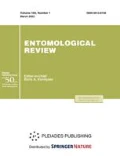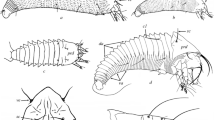Abstract
A review on the complex of species of eriophyoid mites associated with Rosaceae is given, focused on the phylogeny, biology, and distribution of their host plants and galls induced by these mites. About 200 species of 39 genera from 3 families ofEriophyoidea are known from Rosaceae. Among them, 6 species from 2 genera belong to Phytoptidae, 178 species from 27 genera, to Eriophyidae, and 28 species from 10 genera, to Diptilomiopidae; 7 genera of the latter family are represented on Rosaceae by a single species each. The ability to induce galls is discussed using the example of the most widespread and numerous genera of the family Eriophyidae from Rosaceae. Mites of two large subfamilies, Eriophyinae and Phyllocoptinae, include both vagrant and concealed forms. The types of galls caused by mites are related to the systematic position of mites and the distribution of mites and their host plants. The hypothesis of host shifts of eriophyoid mites from other plant families to Rosaceae is considered. Most of the species which presumably switched to Rosaceae have been described from Southeast Asia. Morphological similarity between vagrant and concealed forms from the paraphyletic tribes Eriophyini and Phyllocoptini, and also Aceriini and Anthocoptini is discussed. Their pairwise similarity might be the result of evolution (Eriophyini → Phyllocoptini and Aceriini → Anthocoptini) connected with change oflife style.
Similar content being viewed by others
References
Amrine, J.W. Jr. and Stasny, T.A., Catalog of the Eriophyoidea (Acarina: Prostigmata) of the World (Indira Publishing House, West Bloomfield, Michigan, 1994).
Amrine, J.W. Jr., Stasny, T.A., and Flechtmann, C.H.W., Revised Keys to the World Genera of the Eriophyoidea (Acari: Prostigmata) (Indira Publishing House, West Bloomfield, Michigan, 2003).
Bagnyuk, I.G., Sukhareva, S.I., and Shevchenko, V.G., “Main Directions of Evolution of Four-Legged Mites as a Specialized Group, by the Example of the Families Pentasetacidae Shev., Nalepellidae Roiv., and Phytoptidae Murray (Acari: Tetrapodili),” Acarina 6 (1-2), 59–76 (1998).
Bruchmann, I., Plant Endemism in Europe: Spatial Distribution and Habitat Affinities of Endemic Vascular Plants. Dissertation (University of Flensburg, 2011). www.zhb-Flensburg. de/dissert/bruchmann.
Chen, X.R., Wei, S.G., and Nan, S.B., “A New Species of Phytoptinae (Acari: Phytoptidae) from China,” Acta Zootaxonomica Sinica 30 (1), 81–83 (2005).
Chetverikov, P.E., “Confocal Laser Scanning Microscopy Technique for the Study of Internal Genitalia and External Morphology of Eriophyoid Mites (Acari: Eriophyoidea),” Zootaxa 3453 (5), 56–68 (2012).
Chetverikov, P.E., “Evolutionary Plasticity of Highly Specialized Organisms, by the Example of Eriophyoidea (Acariformes),” Zhumal Obshchei Biologii 76 (1), 15–25 (2015).
Chetverikov, P.E., “Generic Delimitation between Fragariocoptes and Sierraphytoptus (Acari: Eriophyoidea: Phytoptidae) and a Supplementary Description of Fragariocoptes gansuensis with Remarks on Searching for Mummified Eriophyoid Mites in Herbaria under UV Light,” Zootaxa 4066 (3), 271–290 (2016a).
Chetverikov, P.E., “Main Evolutionary Directions of Eriophyoid Mites (Eriophyoidea),” in Coevolution of Parasites and Their Hosts, Ed. by K.V. Galaktionov (Zoological Institute, St. Petersburg, 2016b), pp. 349–376 [in Russian]
Chetverikov, P.E. and Bolton, S., “Suboral Fork: A Newly Discerned Gnathosomal Structure from the Proboscis of Eriophyoid Mites (Acari, Eriophyoidea),” Experimental and Applied Acarology 70 (2), 137–153 (2016).
Chetverikov, P.E. and Craemer, C., “Gnathosomal Interlocking Apparatus and Remarks on Functional Morphology of Frontal Lobes of Eriophyoid Mites (Acariformes, Eriophyoidea),” Experimental and Applied Acarology 66 (2), 187–202 (2015).
Chetverikov, P.E. and Craemer, C., “Sierraphytoptines (Eriophyoidea: Phytoptidae) from Relict Eudicots: Reassignment of Sierraphytoptus taiwanensus to a New Genus Solenoplatilobus and Refinement of Generic Diagnosis of Austracus,” Systematic and Applied Acarology 21 (6), 745–758 (2016).
Chetverikov, P.E., Cvrković, T., Makunin, A., Sukhareva, S., Vidović, B., and Petanović, R., “Basal Divergence of Eriophyoidea (Acariformes, Eupodina) Inferred from Combined Partial COI and 28S Gene Sequences and CLSM Genital Anatomy,” Experimental and Applied Acarology 67 (2), 219–245 (2015).
Chetverikov, P.E. and Desnitskiy, A.G., “A Study of Embryonic Development in Eriophyoid Mites (Acariformes, Eriophyoidea) with the Use of the Fluorochrome DAPI and Confocal Microscopy,” Experimental and Applied Acarology 68 (1), 97–111 (2016).
Chetverikov, P.E., Hörweg, C., Kozlov, M.I., and Amrine, J.W. Jr., “Reconditioning of the Nalepa Collection of Eriophyoid Mites (Acariformes, Eriophyoidea),” Systematic and Applied Acarology 21 (5), 583–595 (2016).
Chetverikov, P.E., Petanović, R.U., and Sukhareva, S.I., “Systematic Remarks on Eriophyoid Mites from the Subfamily Phytoptinae Murray, 1877 (Acari: Eriophyoidea: Phytoptidae),” Zootaxa 2070, 63–68 (2009).
Chetverikov, P.E. and Sukhareva, S.I., “A Revision of the Genus Sierraphytoptus Keifer, 1939 (Eriophyoidea, Phytoptidae),” Zootaxa 2309, 63–68 (2009).
Christenhusz, M.J. and Byng, J.W., “The Number of Known Plants Species in the World and Its Annual Increase,” Phytotaxa 261 (3), 201–217 (2016).
De Lillo, E. and Monfreda, R., “Salivary Secretions of Eriophyoids (Acari: Eriophyoidea): First Results of an Experimental Model,” Experimental and Applied Acarology 34, 291–306 (2004).
DeVore, M.L. and Pigg, K.B., “Biotic Processes in the Okanagan Highlands Floras: Possible Evidence of Hybridization in Plants Adapting to a Temperate Forest,” Canadian Journal of Earth Sciences 53 (6), 622–629 (2016).
Ex, S.A., DeRose, R.J., and Long, J.N., “Stand Development and Population Dynamics of Curlleaf Mountain Mahogany (Cercocarpus ledifolius Nutt.) Woodlands in Utah’s Bear River Mountains,” Western Journal of Applied Forestry 26 (4), 183–188 (2011).
Gladkova, V.N., “Family Rosaceae,” in Life of Plants, Vol. 5, Part 2, Ed. by A.L. Takhtajan (Prosveshchenie, Moscow, 1981), pp. 175–187 [in Russian]
Haston, E., Richardson, J.E., Stevens, P.F., Chase, M.W., and Harris, D.J., “The Linear Angiosperm Phylogeny Group (LAPG) III: A Linear Sequence of the Families in APG III,” Botanical Journal of the Linnean Society 161 (2), 128–131 (2009).
Hummer, K.E. and Janick, J., “Rosaceae: Taxonomy, Economic Importance, Genomics,” in Genetics and Genomics of Rosaceae, Ed. by K.M. Folta and S.E. Gardiner (Springer, New York, 2009), pp. 1–17.
Kedzior, M., Shi, A., Lewandowski, M., and Boczek, J., “Comparison Sequences of Ribosomal DNA ITS 1 and ITS2 of Mites Eriophyes pyri (Pgst.) and Eriophyes mali Nal. (Acari: Eriophyidae),” in Advances in Polish Acarology, Ed. by G. Gabrys and S. Ignatowicz (SGGW, Warszawa, 2006), pp. 112–134.
Keifer, H.H., “Eriophyid Studies XVIII,” Bulletin of the California Department of Agriculture 41 (1), 31–42 (1952).
Keifer, H.H., “Eriophyoidea Nalepa: Injurious Eriophyoid Mites,” in Mites Injurious to Economic Plants, Ed. by L.R. Jeppson, H.H. Keifer, and E.W. Baker (University of California Press, Berkeley, 1975), pp. 327–533.
Korovin, E.P., Flora of Central Asia and South Kazakhstan: Second Edition, Book 1 (Uzbek SSR Academy of Sciences, Tashkent, 1961) [in Russian]
Lancaster, L.T. and Kay, K.M., “Origin and Diversification of the California Flora: Re-Examining Classic Hypotheses with Molecular Phylogenies,” Evolution 67 (4), 1041–1054 (2013).
Laurence, A.A. and Campbell, C.S., “Phylogeny of Rubus (Rosaceae) Based on Nuclear Ribosomal DNA Internal Transcribed Spacer Region Sequences,” American Joumal of Botany 86 (1), 81–97 (1999).
Li, H.S., Xue, X.F., and Hong, X.Y., “Homoplastic Evolution and Host Association of Eriophyoidea (Acari, Prostigmata) Conflict with the Morphological-Based Taxonomic System,” Molecular Phylogenetics and Evolution 78, 185–198 (2014).
Li, H.S., Hoffmann, A.A., Guo, J.F., Zuo, Y., Xue, X.F., Pang, H., and Hong, X.Y., “Identification of Two Lineages of Host-Associated Eriophyoid Mites Predisposed to Different Levels of Host Diversification,” Molecular Phylogenetics and Evolution 105, 235–240 (2016).
Lindquist, E.E., “External Anatomy and Notation of Structures,” in Eriophyoid Mites: Their Biology, Natural Enemies and Control (World Crop Pests 6), Ed. by E.E. Lindquist, M.W. Sabelis, and J. Bruin (Elsevier Science Publishing, Amsterdam, 1996), pp. 3–31.
Lindquist, E.E. and Oldfield, G.N., “Evolution of Eriophyoid Mites in Relation to Their Host Plants,” in Eriophyoid Mites: Their Biology, Natural Enemies and Control (World Crop Pests 6), Ed. by E.E. Lindquist, M.W. Sabelis, and J. Bruin (Elsevier Science Publishing, Amsterdam, 1996), pp. 227–300.
Longhi, S., Giongo, L., Buti, M., Surbanovski, N., Viola, R., Velasco, R., Ward, J.A., and Sargent, D.J., “Molecular Genetics and Genomics of the Rosoideae: State of the Art and Future Perspectives,” Horticulture Research 1, Art. 1 (2014), doi:10.1038/hortres.2014.1.
Omduff, R., Faber, P.M., and Keeler-Wolf, T., Introduction to California Plant Life (University of California Press, 2003).
Potter, D., Eriksson, T., Evans, R.C., Oh, S., Smedmark, J.E.E., Morgan, D.R., Kerr, M., Robertson, K.R., Arsenault, M., Dickinson, T.A., and Campbell, C.S., “Phylogeny and Classification of Rosaceae,” Plant Systematics and Evolution 266, 5–43 (2007).
Schultz, W., Tueller, P.T., and Tausch, R.J., “Ecology of Curlleaf Mahogany in Western and Central Nevada: Community and Population Structure,” Journal of Range Management 43 (1), 13–20 (1990).
Skoracka, A., Magalhaes, S., Rector, B.G., and Kuczyński, L., “Cryptic Speciation in the Acari: A Function of Species Lifestyles or Our Ability to Separate Species?” Experimental and Applied Acarology 67 (2), 165–182 (2015).
Stevens, P.F., Angiosperm Phylogeny Website. Ver. 12 (2001). http://www.mobot.org/MOBOT/research/APweb/ (accessed February 4, 2017).
Sukhareva, S.I., Four-Legged Mites on Grasses (St. Petersburg State University, St. Petersburg, 1992) [in Russian]
Sukhareva, S.I., “Family Phytoptidae Murray, 1877 (Acari: Tetrapodili): Its Composition, Structure, and Probable Evolution Pathways,” Acarina 2 (1-2), 47–72 (1994).
Sukhareva, S.I., “Four-Legged Mites (Acari: Tetrapodili) of the Genus Aceria from Plants of the Family Asteraceae with the Description of a New Species,” Acarina 9 (1), 131–141 (2001).
Sukhareva, S.I. and Chetverikov, P.E., “Morphological Transformations Associated with Passing from Protogynous to Deutogynous Females in Eriophyoid Mites (Acari: Eriophyoidea),” Vestnik Sankt-Peterburgskogo Universiteta 3(1), 3–15 (2013).
Töpel, M., Antonelli, A., Yesson, C., and Eriksen, B., “Past Climate Change and Plant Evolution in Western North America: A Case Study in Rosaceae,” PLoS One 7 (12), e50358 (2012).
Vidović, B., Marinković, S., Marić, I., and Petanović, R., “Comparative Morphological Analysis of Apple Blister Mite, Eriophyes mali Nal., a New Pest in Serbia,” Pesticides and Phytomedicine 29 (2), 123–130 (2014).
Westphal, E. and Manson, D.C.M., “Feeding Effects on Host Plants: Gall Formation and Other Distortions,” in Eriophyoid Mites: Their Biology, Natural Enemies and Control (World Crop Pests 6), Ed. by E.E. Lindquist, M.W. Sabelis, and J. Bruin (Elsevier Science Publishing, Amsterdam, 1996), pp. 231–242.
Xue, X.F., Dong, Y., Deng, W., Hong, X.Y., and Shao, R., “The Phylogenetic Position of Eriophyoid Mites (Superfamily Eriophyoidea) in Acariformes Inferred from the Sequences of Mitochondrial Genomes and Nuclear Small Subunit (18S) rRNA Gene,” Molecular Phylogenetics and Evolution 109, 271–282 (2017).
Author information
Authors and Affiliations
Corresponding author
Additional information
Original Russian Text © S.I. Sukhareva, A.A. Pautov, I.E. Dodueva, P.E. Chetverikov, 2017, published in Entomologicheskoe Obozrenie, 2017, Vol. 96, No. 4, pp. 854-871.
Rights and permissions
About this article
Cite this article
Sukhareva, S.I., Pautov, A.A., Dodueva, I.E. et al. Eriophyoid Mites (Acariformes, Eriophyoidea) from Rosaceae: Taxonomic Diversity, Host-Parasite Relationships, and Ability to Cause Galls. Entmol. Rev. 97, 1378–1390 (2017). https://doi.org/10.1134/S0013873817090160
Received:
Published:
Issue Date:
DOI: https://doi.org/10.1134/S0013873817090160




